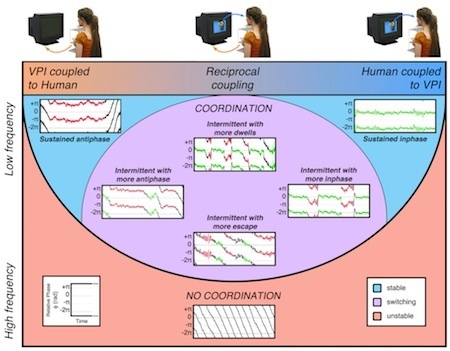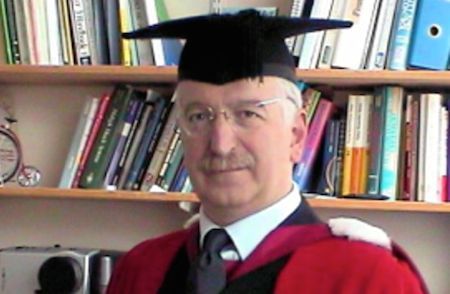Marc Abrahams's Blog, page 384
August 20, 2014
Students’ backpack shoulder-slinging: Asymmetry effects
Should you take sides on the debate about whether children should or should not carry their backpacks on (or mostly on) just one shoulder? This study adds fuel to one or another side of the debate:
 “Effects of Carrying a Backpack in an Asymmetrical Manner on the Asymmetries of the Trunk and Parameters Defining Lateral Flexion of the Spine,” Justyna Drzał-Grabiec [pictured here], Sławomir Snela, Maciej Rachwał, Justyna Podgórska, Justyna Rykała, Human Factors, epub August 8, 2014. (Thanks to investigator Neil Martin for bringing this to our attention.) The authors, at Rzeszow University, Rzeszow, Poland, report:
“Effects of Carrying a Backpack in an Asymmetrical Manner on the Asymmetries of the Trunk and Parameters Defining Lateral Flexion of the Spine,” Justyna Drzał-Grabiec [pictured here], Sławomir Snela, Maciej Rachwał, Justyna Podgórska, Justyna Rykała, Human Factors, epub August 8, 2014. (Thanks to investigator Neil Martin for bringing this to our attention.) The authors, at Rzeszow University, Rzeszow, Poland, report:
The aim of this study was to examine changes in the body posture parameters defining asymmetry of the trunk and lateral flexion of the spine in children while carrying a backpack weighing 10% of a child’s weight…
Results: Trunk inclination shifted significantly in the opposite direction to the shoulder the backpack was carried on, and an increase in shoulder asymmetry was also found. We also observed a more pronounced right-side lateral flexion of the spine when the backpack was carried on the right shoulder and an analogous relationship for the left side.
Conclusion: The results of this study show that carrying a backpack in an asymmetrical manner negatively affects spine, even if the backpack weight constitutes 10% of the child’s weight, which has been previously recommended as a safe load for a child’s shoulders.
Here is a video of an older student carrying a backpack on one shoulder:

“… yet the world it describes is a mess”
“Physics may aim for simplicity, yet the world it describes is a mess.”
That’s the start of John Cartwright’s article, “Roll Over, Bolzmann,” in the magazine Physics World. It tells the story of Tsallis entropy:
Our definition of entropy is expressed by one of the most famous formulae in physics, and dates back over a century to the work of the Austrian physicist Ludwig Boltzmann [pictured here] and the American chemist J Willard Gibbs. For more than 20 years, however, the Greek-born physicist Constantino Tsallis, who is based at the Brazilian Centre for Physics Research (CBPF) in Rio de Janeiro, has been arguing that entropy is in need of some refinement. The situation, according to Tsallis, is rather like Newtonian mechanics – a theory that works perfectly until speeds approach that of light, at which point Einstein’s special theory of relativity must take over. Likewise, says Tsallis, entropy – as defined by Boltzmann and Gibbs – works perfectly, but only within certain limits….
(Thanks to Ig Nobel Prize winner Andrea Rapisarda for bringing this to our attention.)

The smell of macaroni [part 2]
Q. How do Macaroni penguins smell?
A. Pretty bad.
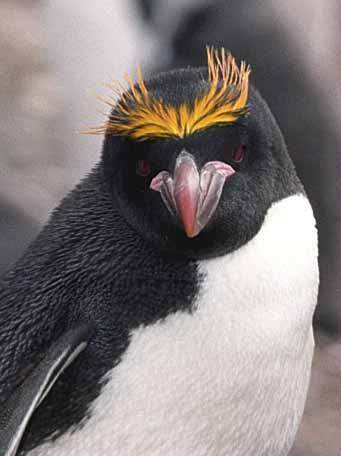 For example, Lindeboom [1984] estimated that 220 kg NH3-N was volatilized daily from a rookery on Subantarctic Marion Island occupied by 350000 macaroni penguins, and reported that the odor was apparent up to 10 km from the source.
For example, Lindeboom [1984] estimated that 220 kg NH3-N was volatilized daily from a rookery on Subantarctic Marion Island occupied by 350000 macaroni penguins, and reported that the odor was apparent up to 10 km from the source.
More details can be found here.
Previous article: The smell of macaroni [part 1]
Coming soon: The smell of macaroni [part 3]
Photo credit: Via Wikpedia : ‘Macaroni Penguin, Hannah Point, Livingston Island: 62°39′S, 60°36′W, Antarctic Peninsula’. Author: Jerzy Strzelecki

August 19, 2014
The Human Dynamic Clamp
Social scientists, some of them, love to imitate and perhaps surpass what non-social scientists have done. This study may be an example (the paper does not directly indicate how social are the scientists who wrote it):
“The human dynamic clamp as a paradigm for social interaction,” Guillaume Dumas, Gonzalo C. de Guzman, Emmanuelle Tognoli, and J.A. Scott Kelso, Proceedings of the National Academy of Sciences, epub July 17, 2014. (Thanks to investigator Neil Martin for bringing this to our attention.) The authors, at Florida Atlantic University, USA and the University of Ulster, UK, explain:
“Combining mathematical and neurophysiological methods, we introduce a paradigm called the human dynamic clamp (HDC), to directly manipulate the interaction or coupling between a human and a surrogate constructed to behave like a human. Inspired by the dynamic clamp used so productively in cellular neuroscience, the HDC allows a person to interact in real time with a virtual partner itself driven by well-established models of coordination dynamics….
“The HDC not only enables to test the veracity of theoretical models, it also illuminates features that are not always apparent in real-time human social interactions and the brain correlates thereof.”
Here’s further detail from the paper:

“Q”. Just Q. That’s the whole title. Plus other terse titles.
This paper qualifies in the competition, if there is one, for Research Paper with the Shortest Title. The paper is:
“Q“, by Leon Knopoff [pictured here], Reviews of Geophysics, vol. 2, no. 4, 1964, pp. 625-660. The author, at the Department of Physics and Institute of Geophysics and Planetary Physics, University of California, Los Angeles, begins:
“Were it not for the intrinsic attenuation of sound in the earth’s interior, the energy of earthquakes of the past would still reverberate through the interior of the earth today. The chaos resulting from this awesome prospect is a speculation which lies outside the scope of this paper. Rather, it is the task here to investigate where in the earth seismic energy is converted into heat; is this performed with equal efficiency everywhere in the interior, or are some parts of the interior more capable of performing this operation than others.”
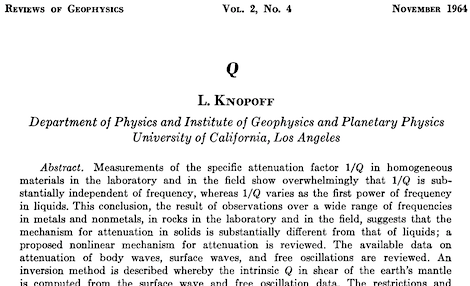
Here is a graph from the study:
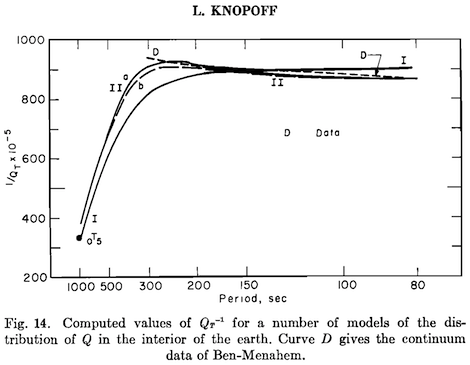
(Thanks to investigator Hezi Gildor for bringing this to our attention.)
BONUS: If you know of another top-rate research paper that have a title as short or shorter than the title of this paper, we would enjoy hearing about it.
UPDATE: That paper apparently was the first in an adventure series. A later item in that series:
“Q in the Solar System,” Peter Goldreich and Steven Soter, Icarus, vol. 5, no. 1966, pp. 375-389. (Thanks to investigator David Grinspoon for bringing this to our attention.) The authors are, or were, at the University of California at Los Angeles.
UPDATE: Another terse title:
“&,” Christopher J. Mulvey, Supplemento ai Rendiconti del Circolo Matematico di Palermo, 1986. (Thanks to investigator Lucius Schoenbaum for bringing this to our attention.) The author is at the University of Sussex.

Does chewing gum improve our mind and our productivity?
For advocates of chewing gum in school, if there are any, the past decade of research has brought data, and perhaps hope. A project called The Effects of Gum Chewing on Math Scores in Adolescents studied the mathematics grades and test scores of 53 teenage students who chewed gum and 58 who did not. Craig Johnston of the Baylor College of Medicine in Houston, Texas, led the study. It was sponsored by the Wm Wrigley Jr Company, which makes chewing gum….
—So begins another Improbable Research column in The Guardian.

A three-minute 24-second struggle with the laws of physics
This video, 3:24 in duration*, shows a struggle to insert one object into another. It’s a struggle against some known, but perhaps not fully understood, laws of Newtonian physics. It is also perhaps an illustration of the Dunning-Kruger effect.
* give or take a second
BONUS: The 2000 Ig Nobel Prize for psychology was awarded to David Dunning of Cornell University and Justin Kruger of the University of Illinois, for their modest report, “Unskilled and Unaware of It: How Difficulties in Recognizing One’s Own Incompetence Lead to Inflated Self-Assessments” [Journal of Personality and Social Psychology, vol. 77, no. 6, December 1999, pp. 1121-34.]

August 18, 2014
An effect of croquet on predator/parasite author order
Scientists sometimes find clever ways to decide contentious questions. Witness the method mentioned in this paper:
“Aggregation of predators and insect parasites and its effect on stability,” M.P. Hassell and Robert M. May, Journal of Animal Ecology, 1974, pp. 567-594. (Thanks to investigator Betsy Devine for bringing this to our attention.) In the 1974 predators/parasites paper, May and his coauthor wrote:
“The order of authorship was determined from a twenty-five-game croquet series held at Imperial College Field Station during summer 1973.”
[A CURIOUS HISTORICAL NOTE: Two decades after this paper appeared, Robert May held the post of Chief Scientific Advisor to the UK government. In 1995 he asked the Ig Nobel Board of Governors to stop giving Ig Nobel Prizes to British scientists — even if those scientists wanted to be awarded the prizes. The incident was celebrated in the science journalism world at the time, and years later was celebrated in a popular Japanese manga.]

A celebration of Italy’s Ig Nobel Prize winners
NanoPress published a fond profile of all the Italian winners of the Ig Nobel Prize: “IG Nobel italiani: i vincitori di tutte le edizioni“.
Here is one of them, 2013 Ig Nobel Physics Prize co-winner Alberto Minetti:
Throughout Italy, people will be staying up late to watch the live webcast of this year’s Ig Nobel Prize ceremony, on September 18 — to see the new crop of Ig Nobel Prize winners. (In Italy, the webcast will be happening during the magical middle-of-the-night hours as Thursday, September 18 becomes Friday, September 19).

The smell of macaroni [part 1: snakes]
Q. Are garter snakes attracted to the smell of macaroni?
A. Probably not, in general – though things can change dramatically if it’s coated in frog skin mucus.
 The picture shows a checkered garter snake (Thamnophis marcianus) enthusiastically attacking a macarono which has a light coating of frog skin mucus sauce.
The picture shows a checkered garter snake (Thamnophis marcianus) enthusiastically attacking a macarono which has a light coating of frog skin mucus sauce.
See:Identification and Characterization of New Protein Chemoattractants in the Frog Skin Secretome* (in: Molecular & Cellular Proteomics, 5, November 2006, 2114-2123)
Note: * “The costs of publication of this article were defrayed in part by the payment of page charges. This article must therefore be hereby marked ‘advertisement’ in accordance with 18 U.S.C. Section 1734 solely to indicate this fact.”
Coming soon: The smell of macaroni [part 2]

Marc Abrahams's Blog
- Marc Abrahams's profile
- 14 followers


